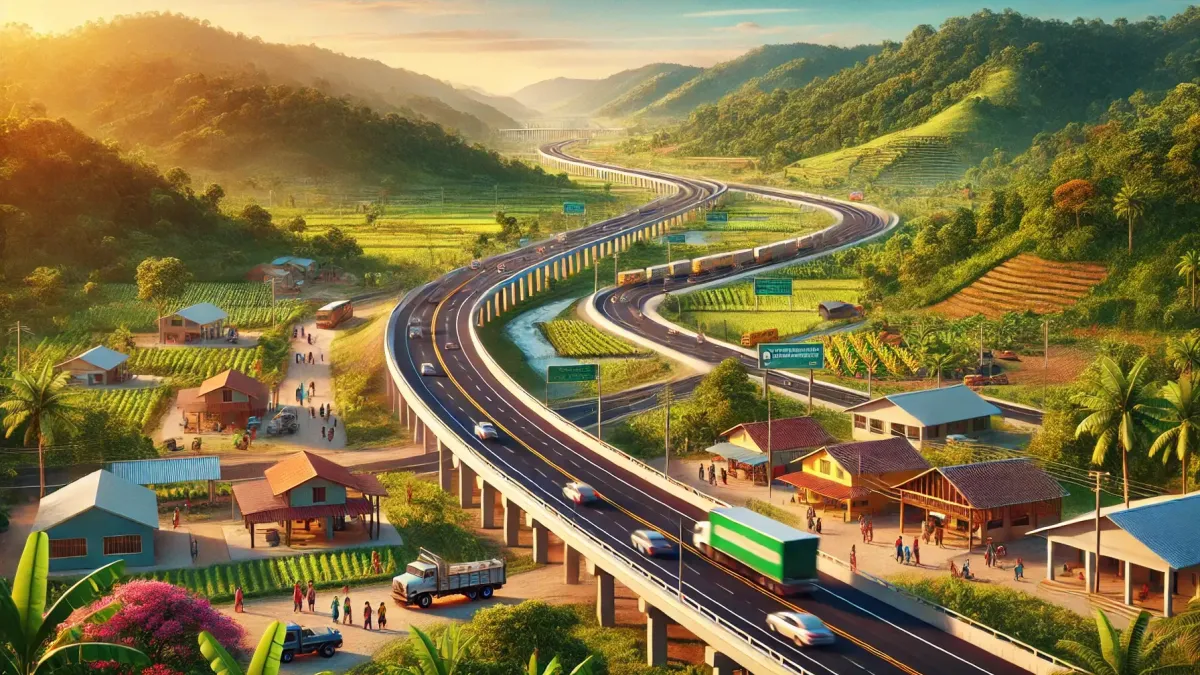R.E.News International-New Road Corridor is Transforming Northwestern Honduras
 21/01/25-FR-English-NL-footer
21/01/25-FR-English-NL-footer
Un nouveau corridor routier transforme le nord-ouest du Honduras
 Image-R.E.News
Image-R.E.News
Le gouvernement hondurien, en collaboration avec la Banque mondiale, se lance dans une initiative révolutionnaire visant à révolutionner l’infrastructure routière du pays.
En s’attaquant aux problèmes de connectivité de longue date et en créant un réseau de transport plus résilient, ce projet ambitieux promet de libérer le potentiel économique tout en favorisant le développement durable.
Un corridor routier stratégique pour le nord-ouest du Honduras
Le Conseil d’administration de la Banque mondiale a donné le feu vert à une opération transformatrice visant à construire un nouveau corridor routier vital. S’étendant sur 46 kilomètres, le corridor reliera l’autoroute CA-4 près de Macuelizo à la route CA-13 à Corinto, une municipalité stratégiquement située près du principal port du pays, Puerto Cortés. Avec un investissement de 187 millions de dollars, ce projet vise à fournir une alternative solide à la route commerciale de San Pedro Sula, très encombrée.
Ce développement devrait bénéficier à près de 194 000 résidents en améliorant l’accès aux installations douanières de Corinto et en renforçant les échanges avec les pays voisins, le Guatemala et le Salvador. En réduisant les goulets d’étranglement à San Pedro Sula, le nouveau corridor rationalisera le transport de marchandises et renforcera l’efficacité du réseau logistique national, même pendant les fortes pluies notoires de la région.
San Pedro Sula, reconnue comme le centre névralgique économique du Honduras, est depuis longtemps aux prises avec des problèmes de congestion. En tant que principale plaque tournante reliant la côte atlantique du pays à d’autres régions, les routes de la ville sont confrontées à des goulets d’étranglement paralysants, en particulier lors des événements météorologiques de pointe. Cela ralentit non seulement les échanges commerciaux, mais met également à rude épreuve les infrastructures de la ville.
Le Projet de connectivité durable du Honduras (HSCP) relève ce défi en introduisant une nouvelle route artérielle. En fournissant un itinéraire alternatif, le projet promet non seulement un soulagement logistique, mais réduit également la dépendance à San Pedro Sula comme seule porte d’entrée vers les principaux ports du pays.
En tandem avec le nouveau corridor, le projet comprend le pavage d’environ 41 kilomètres de routes existantes dans les municipalités de Quimistán, Azacualpa, Nueva Frontera et Macuelizo. Bon nombre de ces routes, qui jouent un rôle essentiel dans la connectivité locale, ont souffert d’une grave détérioration.
Dans le cadre du programme d’interconnexion des routes municipales du gouvernement hondurien, ces améliorations renforceront la résilience climatique et amélioreront l’accès aux services essentiels et aux opportunités économiques. Les habitants de ces zones, où les niveaux de pauvreté varient entre 70 et 90 %, devraient bénéficier considérablement d’une mobilité et d’une croissance économique améliorées.
« Au nom du gouvernement du président Xiomara Castro, nous tenons à remercier la Banque mondiale pour son soutien inestimable au projet routier, qui vise à offrir un accès plus sûr et plus résilient au changement climatique dans le nord-ouest du Honduras », a déclaré Christian Duarte, ministre des Finances du Honduras.
Au-delà de la connectivité, le projet est sur le point d’agir comme un catalyseur du développement économique. L’amélioration des infrastructures routières ouvrira des possibilités de création d’emplois, élargira l’accès au marché et favorisera la croissance des entreprises locales. Avec l’augmentation du flux de circulation entre les municipalités, les résidents peuvent s’attendre à un meilleur accès aux soins de santé, à l’éducation et aux opportunités d’emploi.
L’essor économique de la région ne concerne pas seulement les routes ; il concerne les vies transformées par elles. En reliant les communautés isolées, ce projet jette les bases d’une croissance inclusive et d’un avenir meilleur pour l’une des régions les plus pauvres du Honduras.
Il est intéressant de noter que le projet ne s’arrête pas aux infrastructures ; il est également profondément ancré dans la durabilité. Un élément unique se concentre sur la gestion des paysages autour du corridor pour promouvoir des activités durables et la conservation de la biodiversité. Les principales initiatives comprennent la restauration des forêts, la récupération des paysages dégradés et les projets d’écotourisme menés par la communauté.
Nichée près du parc national de Cusuco, riche en biodiversité, la région abrite plus de 960 espèces, dont beaucoup sont endémiques de la Méso-Amérique. La préservation de ce trésor écologique est primordiale. Il est encourageant de constater que le projet soutiendra des initiatives menées par des femmes, favorisant l’entrepreneuriat et le développement durable tout en garantissant la préservation de la beauté naturelle de la région pour les générations à venir.
Le Honduras étant régulièrement confronté à des phénomènes météorologiques extrêmes, la construction d’un réseau de transport résilient n’est pas seulement une nécessité, mais une bouée de sauvetage. Le nouveau corridor sera fortifié pour résister aux défis climatiques, garantissant une connectivité ininterrompue en cas de conditions défavorables.
Kinnon Scott, représentant résident de la Banque mondiale au Honduras, a souligné l’importance de cette initiative : « Le Honduras est confronté à des défis considérables causés par des phénomènes météorologiques extrêmes. Il est donc essentiel de disposer d’un réseau routier résilient qui renforce la connectivité et accroît les échanges commerciaux. Le nouveau corridor favorisera un développement territorial intégré, qui stimulera le développement économique de la région et créera des opportunités d’emploi et un accès aux services de base, améliorant ainsi la qualité de vie des habitants de la zone du projet. »
Le projet de connectivité durable du Honduras incarne une approche avant-gardiste et holistique du développement. En combinant la modernisation des infrastructures avec la gestion environnementale et l’amélioration des communautés, le projet répond aux besoins immédiats et à long terme.
Ses effets d’entraînement devraient transformer non seulement la région du nord-ouest, mais aussi le Honduras dans son ensemble, ouvrant la voie à un avenir plus prospère et plus connecté.
Ce projet ambitieux signifie plus qu’un simple réseau routier ; c’est une lueur d’espoir pour le nord-ouest du Honduras. En créant des liens entre les communautés, en favorisant la croissance économique et en protégeant l'environnement, l'initiative incarne la vision d'une nation résiliente et prospère.
Alors que les bulldozers arrivent et que la construction commence, les habitants de Quimistán, Azacualpa et au-delà peuvent s'attendre à un avenir où les opportunités frappent à leur porte, qu'il pleuve ou qu'il fasse beau.
NJC.© Info World Bank’s
---------------------------------------------------------------------------------------------------------------
 21/01/25-English
21/01/25-English
New Road Corridor is Transforming Northwestern Honduras
 Image-R.E.News
Image-R.E.News
The Honduran Government, in collaboration with the World Bank, is embarking on a ground-breaking initiative to revolutionise the country’s road infrastructure.
By addressing long-standing connectivity challenges and creating a more resilient transport network, this ambitious project promises to unlock economic potential while fostering sustainable development.
A Strategic Road Corridor for Northwestern Honduras
The World Bank’s Board of Executive Directors has greenlit a transformative operation aimed at constructing a vital new road corridor. Stretching 46 kilometres, the corridor will connect the CA-4 highway near Macuelizo to the CA-13 road in Corinto, a municipality strategically positioned near the country’s principal port, Puerto Cortés. With a $187 million investment, this project aims to provide a robust alternative to the heavily congested San Pedro Sula trade route.
This development is expected to benefit nearly 194,000 residents by enhancing access to customs facilities in Corinto and bolstering trade with neighbouring Guatemala and El Salvador. By alleviating the bottlenecks in San Pedro Sula, the new corridor will streamline goods transport and reinforce the efficiency of the national logistics network, even during the region’s notorious heavy rainfall.
San Pedro Sula, recognised as Honduras’ economic nerve centre, has long grappled with congestion issues. As the primary hub linking the nation’s Atlantic coast to other regions, the city’s roadways face crippling bottlenecks, especially during peak weather events. This not only slows down trade but also strains the city’s infrastructure.
The Honduras Sustainable Connectivity Project (HSCP) addresses this challenge by introducing a new arterial road. By providing an alternative route, the project not only promises logistical relief but also reduces dependency on San Pedro Sula as the sole gateway to the country’s key ports.
In tandem with the new corridor, the project encompasses the paving of approximately 41 kilometres of existing roadways in the municipalities of Quimistán, Azacualpa, Nueva Frontera, and Macuelizo. Many of these roads, integral to local connectivity, have suffered from severe deterioration.
Under the Honduran Government’s Municipal Interconnection Roads Program, these upgrades will strengthen climate resilience and improve access to essential services and economic opportunities. Residents in these areas, where poverty levels range between 70 to 90 per cent, stand to benefit significantly from enhanced mobility and economic growth.
“On behalf of the Government of President Xiomara Castro, we would like to thank the World Bank for its invaluable support with the Roads Project, which aims to provide safer, more climate-resilient access in northwestern Honduras,” stated Christian Duarte, Honduras’ Minister of Finance.
Beyond connectivity, the project is poised to act as a catalyst for economic development. Improved road infrastructure will unlock opportunities for job creation, expand market access, and foster the growth of local businesses. With increased traffic flow between municipalities, residents can expect greater access to healthcare, education, and employment opportunities.
The region’s economic uplift isn’t just about roads; it’s about the lives transformed by them. By bridging isolated communities, this project lays the groundwork for inclusive growth and a brighter future for one of Honduras’ most impoverished regions.
Interestingly, the project doesn’t stop at infrastructure; it’s also deeply rooted in sustainability. A unique component focuses on managing landscapes around the corridor to promote sustainable activities and biodiversity conservation. Key initiatives include forest restoration, degraded landscape recovery, and community-led ecotourism projects.
Nestled near the biodiverse Cusuco National Park, the region is home to over 960 species, many of which are endemic to Mesoamerica. Preserving this ecological treasure is paramount. Encouragingly, the project will support initiatives led by women, fostering entrepreneurship and sustainable development while ensuring the region’s natural beauty is safeguarded for generations to come.
With Honduras regularly facing extreme weather events, building a resilient transport network is not just a necessity but a lifeline. The new corridor will be fortified to withstand climatic challenges, ensuring uninterrupted connectivity during adverse conditions.
Kinnon Scott, the World Bank’s Resident Representative in Honduras, highlighted the significance of this endeavour: “Honduras is facing significant challenges caused by extreme weather events, so a resilient road network that strengthens connectivity and increases trade is of critical importance. The new corridor will foster integrated territorial development, which will boost economic development in the region and create job opportunities and access to basic services, improving the quality of life of the people in the project area.”
The Honduras Sustainable Connectivity Project epitomises a forward-thinking, holistic approach to development. By combining infrastructure upgrades with environmental stewardship and community upliftment, the project addresses both immediate and long-term needs.
Its ripple effects are set to transform not only the northwestern region but also Honduras as a whole, paving the way for a more prosperous, connected future.
This ambitious project signifies more than just a road network; it’s a beacon of hope for northwestern Honduras. By bridging communities, fostering economic growth, and safeguarding the environment, the initiative embodies a vision for a resilient and thriving nation.
As bulldozers roll in and construction begins, the residents of Quimistán, Azacualpa, and beyond can look forward to a future where opportunity knocks on their doorstep, rain or shine.
NJC.© Info World Bank’s
---------------------------------------------------------------------------------------------------------------
 21/01/25-NL
21/01/25-NL
Nieuwe wegencorridor transformeert Noordwest-Honduras
 Image-R.E.News
Image-R.E.News
De Hondurese regering start, in samenwerking met de Wereldbank, een baanbrekend initiatief om de wegeninfrastructuur van het land te revolutioneren.
Door langdurige connectiviteitsproblemen aan te pakken en een veerkrachtiger transportnetwerk te creëren, belooft dit ambitieuze project economisch potentieel te ontsluiten en tegelijkertijd duurzame ontwikkeling te bevorderen.
Een strategische wegencorridor voor Noordwest-Honduras
De Raad van Bestuur van de Wereldbank heeft groen licht gegeven voor een transformatieve operatie die gericht is op de bouw van een vitale nieuwe wegencorridor. De corridor is 46 kilometer lang en verbindt de snelweg CA-4 nabij Macuelizo met de weg CA-13 in Corinto, een gemeente die strategisch is gelegen nabij de belangrijkste haven van het land, Puerto Cortés. Met een investering van $ 187 miljoen wil dit project een robuust alternatief bieden voor de zwaar overbelaste handelsroute San Pedro Sula.
Deze ontwikkeling zal naar verwachting bijna 194.000 inwoners ten goede komen door de toegang tot douanefaciliteiten in Corinto te verbeteren en de handel met buurlanden Guatemala en El Salvador te stimuleren. Door de knelpunten in San Pedro Sula te verlichten, zal de nieuwe corridor het goederenvervoer stroomlijnen en de efficiëntie van het nationale logistieke netwerk versterken, zelfs tijdens de beruchte hevige regenval in de regio.
San Pedro Sula, erkend als het economische zenuwcentrum van Honduras, worstelt al lang met congestieproblemen. Als het belangrijkste knooppunt dat de Atlantische kust van het land verbindt met andere regio's, kampen de wegen van de stad met verlammende knelpunten, vooral tijdens piekweersomstandigheden. Dit vertraagt niet alleen de handel, maar belast ook de infrastructuur van de stad.
Het Honduras Sustainable Connectivity Project (HSCP) pakt deze uitdaging aan door een nieuwe hoofdweg te introduceren. Door een alternatieve route te bieden, belooft het project niet alleen logistieke verlichting, maar vermindert het ook de afhankelijkheid van San Pedro Sula als enige toegangspoort tot de belangrijkste havens van het land.
Samen met de nieuwe corridor omvat het project de verharding van ongeveer 41 kilometer aan bestaande wegen in de gemeenten Quimistán, Azacualpa, Nueva Frontera en Macuelizo. Veel van deze wegen, die essentieel zijn voor de lokale connectiviteit, hebben te lijden gehad van ernstige achteruitgang.
Onder het Municipal Interconnection Roads Program van de Hondurese regering zullen deze upgrades de klimaatbestendigheid versterken en de toegang tot essentiële diensten en economische kansen verbeteren. Inwoners in deze gebieden, waar het armoedeniveau varieert van 70 tot 90 procent, zullen aanzienlijk profiteren van verbeterde mobiliteit en economische groei.
"Namens de regering van president Xiomara Castro willen we de Wereldbank bedanken voor haar onschatbare steun met het Roads Project, dat gericht is op het bieden van veiligere, meer klimaatbestendige toegang in noordwestelijk Honduras", aldus Christian Duarte, minister van Financiën van Honduras.
Naast connectiviteit is het project klaar om te fungeren als een katalysator voor economische ontwikkeling. Verbeterde wegeninfrastructuur zal kansen bieden voor het creëren van banen, de markttoegang vergroten en de groei van lokale bedrijven stimuleren. Met een toegenomen verkeersstroom tussen gemeenten kunnen inwoners meer toegang verwachten tot gezondheidszorg, onderwijs en werkgelegenheid.
De economische opleving van de regio gaat niet alleen over wegen; het gaat over de levens die erdoor worden getransformeerd. Door geïsoleerde gemeenschappen te overbruggen, legt dit project de basis voor inclusieve groei en een betere toekomst voor een van de meest verarmde regio's van Honduras.
Interessant genoeg stopt het project niet bij infrastructuur; het is ook diepgeworteld in duurzaamheid. Een uniek onderdeel richt zich op het beheer van landschappen rond de corridor om duurzame activiteiten en biodiversiteitsbehoud te bevorderen. Belangrijke initiatieven zijn onder meer bosherstel, herstel van gedegradeerd landschap en door de gemeenschap geleide ecotoerismeprojecten.
De regio ligt genesteld in de buurt van het biodiverse Cusuco National Park en herbergt meer dan 960 soorten, waarvan er veel endemisch zijn voor Meso-Amerika. Het behoud van deze ecologische schat is van het grootste belang. Het is bemoedigend dat het project initiatieven van vrouwen zal ondersteunen, ondernemerschap en duurzame ontwikkeling zal bevorderen en tegelijkertijd de natuurlijke schoonheid van de regio zal beschermen voor toekomstige generaties.
Omdat Honduras regelmatig te maken heeft met extreme weersomstandigheden, is het bouwen van een veerkrachtig transportnetwerk niet alleen een noodzaak, maar ook een levenslijn. De nieuwe corridor zal worden versterkt om bestand te zijn tegen klimatologische uitdagingen, waardoor ononderbroken connectiviteit wordt gegarandeerd tijdens ongunstige omstandigheden.
Kinnon Scott, de vertegenwoordiger van de Wereldbank in Honduras, benadrukte het belang van deze inspanning: "Honduras kampt met aanzienlijke uitdagingen als gevolg van extreme weersomstandigheden, dus een veerkrachtig wegennet dat de connectiviteit versterkt en de handel vergroot, is van cruciaal belang. De nieuwe corridor zal geïntegreerde territoriale ontwikkeling bevorderen, wat de economische ontwikkeling in de regio zal stimuleren en werkgelegenheid en toegang tot basisdiensten zal creëren, waardoor de kwaliteit van leven van de mensen in het projectgebied zal verbeteren."
Het Honduras Sustainable Connectivity Project belichaamt een vooruitstrevende, holistische benadering van ontwikkeling. Door infrastructuurupgrades te combineren met milieubeheer en gemeenschapsverbetering, pakt het project zowel onmiddellijke als langetermijnbehoeften aan.
De rimpeleffecten zullen niet alleen de noordwestelijke regio transformeren, maar ook Honduras als geheel, en de weg vrijmaken voor een welvarendere, verbonden toekomst.
Dit ambitieuze project betekent meer dan alleen een wegennet; het is een baken van hoop voor noordwestelijk Honduras. Door gemeenschappen te overbruggen, economische groei te bevorderen en het milieu te beschermen, belichaamt het initiatief een visie voor een veerkrachtige en bloeiende natie.
Terwijl bulldozers binnenrollen en de bouw begint, kunnen de inwoners van Quimistán, Azacualpa en daarbuiten uitkijken naar een toekomst waarin kansen voor hun deur staan, ongeacht regen of zonneschijn.
NJC.© Info World Bank’s
------------------------------------------------------------------------------------------------------------------
Date de dernière mise à jour : 20/01/2025















